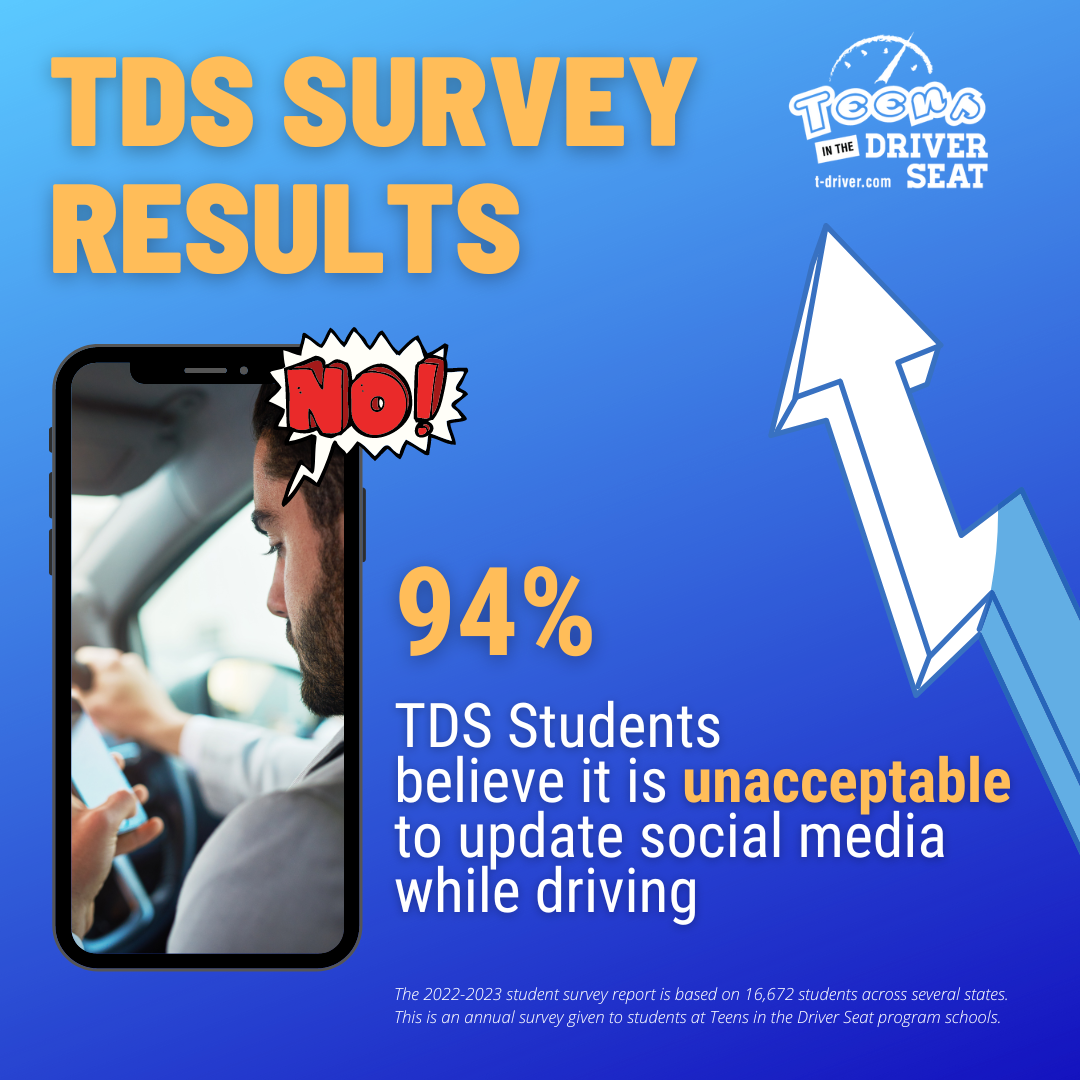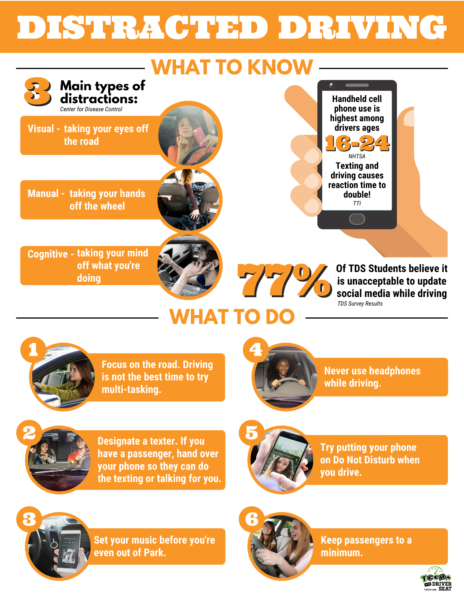 A distraction is anything that takes your mind and attention away from driving
A distraction is anything that takes your mind and attention away from driving
The problem of distractions:
- There are three main types of distraction1:
- Visual — taking your eyes off the road
- Manual — taking your hands off the wheel
- Cognitive — taking your mind off what you’re doing
- A survey by Liberty Mutual and SADD (Students Against Destructive Decisions) found that teens felt pressure to stay connected or “always on” contributed to their need to engage with cell phones, even while driving2:
- 48% of teens reported texting more when alone in their car
- 55% reported texting while driving to update parents
- 37% reported texting to coordinate or confirm event details with friends
- 34% reported taking their eye off the road when receiving an app notification
Cell phones:
- Handheld cellphone use tends to be highest among 16-to-24-year-old drivers3. Females are more likely than males to be killed or injured in a crash of equal severity4.
- Distractions were a factor in 58% of teen crashes observed.5
- A driver is four times more likely to crash when using a cell phone while driving, regardless of whether it’s hand-held or hands-free.6
- Distracted driving-related crashes accounted for 6% (225) of all teen deaths that occurred in 2021.7
- 296 people were killed in crashes involving a distracted teen driver in 2021.7 A 12% increase compared to the previous year (265 in 2020).
- Engaging in visual-manual subtasks (such as reaching for a phone, dialing, and texting) associated with using hand-held phones and other portable devices increased the risk of getting into a crash by three times.8
- Texting and driving causes reaction time to double and those drivers have a harder time staying in their lane and maintaining a consistent speed.9
Passengers:
- More fatal teen crashes occur when passengers (often other teens) are in the car.10
- Over 57% of teens that died as passengers were in vehicles driven by other teens in 2021.10
- Crash risks, and the risk of being killed in a crash, increase as the number of young passengers in the vehicle increases.11
What do TDS students think about distracted driving?:

Not everyone agrees it’s safe. In fact, most students surveyed in the 2022-2023 school year believed it is UNACCEPTABLE to update social media while driving.12
- While we often believe that everyone is doing it and think it’s ok, most of us agree that being safe is the better choice. What do your friends believe?
- Check out our complete story on the latest results from the 2022-2023 Annual Surveys.
What to do about distracted driving:
- Focus on the road. While you are driving is not the time to multitask.
- Keep distractions out of the car. If you know you will be tempted to look at or use your phone, lock it in the trunk or turn it off.
- Ask passengers to obey your rules while they are in the car, meaning buckle up and don’t distract you.
- Designate a texter. If you have a passenger, hand over your phone so they can do the texting and/or talking for you.
- Be a good passenger by not distracting the driver.
- Know that as a driver, you have a responsibility to yourself and others. A vehicle is a heavy machine and should be treated with respect.
- Set your music/radio before you take your car out of Park.
- Never use headphones while driving. It’s illegal and dangerous.
- Keep passengers to a minimum. If every person doesn’t have a seat belt, you have too many passengers.
- If you don’t feel well or are not emotionally able to drive – don’t. Ask for a ride or wait until you are able.
Sources:
- https://www.cdc.gov/motorvehiclesafety/distracted_driving/index.html
- Liberty Mutual & SADD, 2013 https://www.libertymutualgroup.com/about-lm/news/news-release-archive/articles/new-study-finds-teens-fear-of-missing-out-is-proving-to-be-dangerous
- National Highway Traffic Safety Administration (2019). Driver Electronic Device Use in 2018. https://crashstats.nhtsa.dot.gov/Api/Public/ViewPublication/812818
- Kahane, C.J. 2013. Injury vulnerability and effectiveness of occupant protection technologies for older occupants and women. Report no. DOT HS-811-766. Washington, DC: National Highway Traffic Safety Administration as cited by: https://www.iihs.org/topics/fatality-statistics/detail/males-and-females
- Carney, C., McGehee, D.V., Harland, K., Weiss, M. & Raby, M. (2015). Using Naturalistic Driving Data to Assess the Prevalence of Environmental Factors and Driver Behaviors in Teen Driver Crashes (Technical Report). Washington, D.C.: AAA Foundation for Traffic Safety. Retrieved from https://aaafoundation.org/using-naturalistic-driving-data-assess-prevalence-environmental-factors-driver-behaviors-teen-driver-crashes/
- National Safety Council https://nsc-org-storage.azureedge.net/cms/nsc.org/media/site-media/docs/safe-driving/reports/corp-liability-report.pdf
- NHTSA https://crashstats.nhtsa.dot.gov/Api/Public/ViewPublication/813453
- Fitch, G. A., Soccolich, S. A., Guo, F., McClafferty, J., Fang, Y., Olson, R. L., Perez, M. A., Hanowski, R. J., Hankey, J. M., & Dingus, T. A. (2013, April). The impact of hand-held and hands-free cell phone use on driving performance and safety-critical event risk. (Report No. DOT HS 811 757). Washington, DC: National Highway Traffic Safety Administration. Retrieved from https://featured.vtti.vt.edu/2013/05/new-vtti-study-results-continue-to-highlight-the-dangers-of-distracted-driving/
- Texas A&M Transportation Institute https://tti.tamu.edu/news/new-study-says-texting-doubles-a-driver%E2%80%99s-reaction-time/
- Insurance Institute for Highway Safety, Fatality Facts 2021: Teenagers. Retrieved from https://www.iihs.org/topics/fatality-statistics/detail/teenagers#passenger-vehicle-occupants
- Ouimet MC, Pradhan AK, Brooks-Russell A, Ehsani JP, Berviche D, Simons-Morton BG. Young drivers and their passengers: a systematic review of epidemiological studies on crash risk. 2015. Journal of Adolescent Health 57 (1 Suppl): S24-35.
- Texas A&M Transportation Institute, 2020. Based on 2022-2023 Teen Driver Knowledge Survey Results, https://www.t-driver.com/teens-in-the-driver-seat-2022-2023-progress-survey-results/
Updated August 2023
